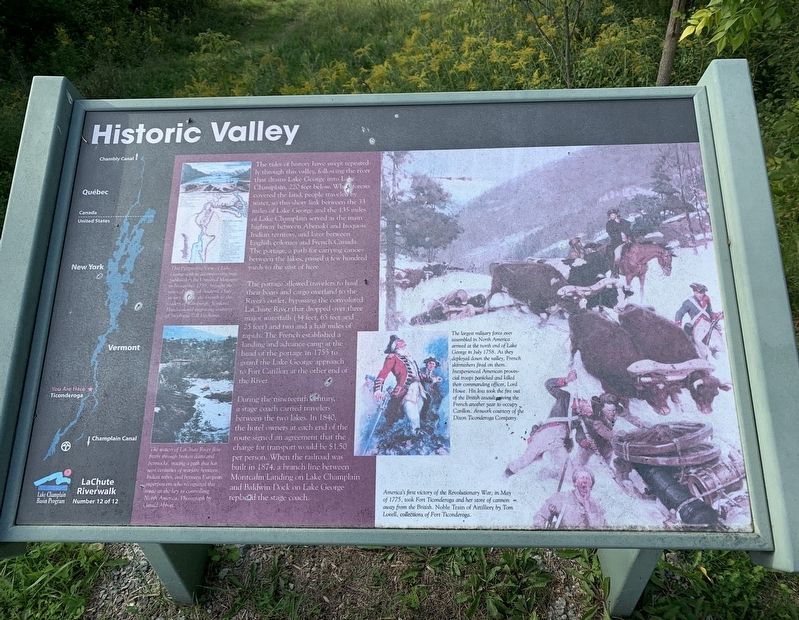Ticonderoga in Essex County, New York — The American Northeast (Mid-Atlantic)
Historic Valley
LaChute Riverwalk
The tides of history have swept repeatedly through this valley, following the river that drains Lake George into Lake Champlain, 220 feet below. When forests covered the land, people traveled by water, so this short link between the 33 miles of Lake George and the 135 miles of Lake Champlain served as the main highway between Abenaki and Iroquois Indian territory, and later between English colonies and French Canada. The portage, a path for carrying canoes between the lakes, passed a few hundred yards to the east of here.
The portage allowed travelers to haul their boats and cargo overland to the River's outlet, bypassing the convoluted LaChute River that dropped over three major waterfalls (34 feet, 65 feet and 25 feet) and two and a half miles of rapids. The French established a landing and advance camp at the head of the portage in 1755 to guard the Lake George approach to Fort Carillon at the other end of the River.
During the nineteenth century, a stage coach carried travelers between the two lakes. In 1840, the hotel owners at each end of the route signed an agreement that the charge for transport would be $1.50 per person. When the railroad was built in 1874, a branch line between Montcalm Landing on Lake Champlain and Baldwin Dock on Lake George replaced the stage coach.
Main Illustration: America's first victory of the Revolutionary War, in May of 1775, took Fort Ticonderoga and her store of cannon away from the British. Noble Train of Artillery by Tom Lovell, collections of Fort Ticonderoga.
Right Inset: The largest military force ever assembled in North America arrived at the north end of Lake George in July 1758. As they deployed down the valley, French skirmishers fired on them. Inexperienced American provincial troops panicked and killed their commanding officer, Lord Howe. His loss took the fire out of the British assault giving the French another year to occupy Carillon: Artwork courtesy of the Dixon Ticonderoga Company.
Top Left Inset: This Perspective View of Lake George published in the Universal Magazine in November 1759, brought the news of General Amherst's July victory over the French to the readers of Edinburgh, Scotland. Hand-colored engraving courtesy of Stephanie Pell Dechame
Bottom Left Inset: The waters of LaChute River flow freely through broken dams and penstocks, tracing a path that has seen centuries of warfare between Indian tribes, and between European superpowers who recognized this route as the key to controlling North America. Photograph by Gerald Abbott. (Marker Number 12.)
Topics. This historical marker is listed in these topic lists: Native Americans • War, French and Indian • War, US Revolutionary • Waterways & Vessels. A significant historical month for this entry is May 1775.
Location. 43° 50.393′ N, 73° 25.721′ W. Marker is in Ticonderoga, New York, in Essex County. Marker is on Lake George Avenue, 0.1 miles north of Alexandria Avenue, on the right when traveling south. Touch for map. Marker is in this post office area: Ticonderoga NY 12883, United States of America. Touch for directions.
Other nearby markers. At least 8 other markers are within walking distance of this marker. "C-Dam" (approx. 0.2 miles away); LaChute River Trail (approx. ¼ mile away); Old Military Road (approx. 0.3 miles away); From this point south… (approx. 0.4 miles away); Military Heroes of Ticonderoga (approx. 0.4 miles away); Mount Defiance (approx. 0.4 miles away); Artillery Park (approx. 0.4 miles away); Lord Howe’s Grave (approx. 0.4 miles away). Touch for a list and map of all markers in Ticonderoga.
Also see . . .
1. French and Indian War (Wikipedia). (Submitted on October 21, 2020, by Steve Stoessel of Niskayuna, New York.)
2. Capture of Fort Ticonderoga (Wikipedia). (Submitted on October 21, 2020, by Steve Stoessel of Niskayuna, New York.)
Credits. This page was last revised on October 26, 2020. It was originally submitted on October 21, 2020, by Steve Stoessel of Niskayuna, New York. This page has been viewed 164 times since then and 17 times this year. Photo 1. submitted on October 21, 2020, by Steve Stoessel of Niskayuna, New York. • Michael Herrick was the editor who published this page.
Editor’s want-list for this marker. A wide view photo of the marker and its surroundings. • Can you help?
